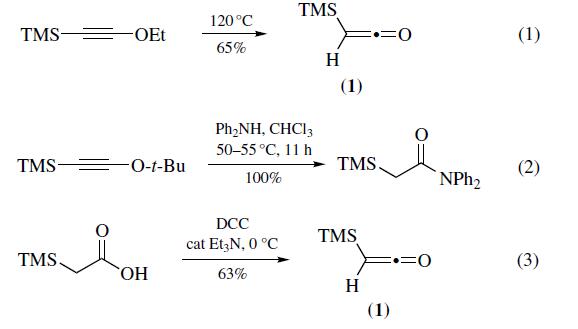Most often prepared (eq 1) by pyrolysis
of ethoxy(trimethylsilyl)acetylene at 120??C (100 mmol scale,
65% yield).Recently, pyrolysis of t-butoxy(trimethylsilyl)
acetylene has been shown to be a convenient alternative for
the preparation of trimethylsilylketene (1). Thermal decomposition
of t-butoxy(trimethylsilyl)acetylene causes elimination
of 2-methylpropene slowly at temperatures as low as 50??C and
instantaneously at 100¨C110??C (30 mmol scale, 63% yield).
The main advantage of this method is that it is possible to generate
trimethylsilylketene in the presence of nucleophiles, leading
to in situ trimethylsilylacetylation (eq 2). Increased shielding
of the triple bond prevents problems such as polymerization
and nucleophilic attack that occur when the ketene is generated
in situ from (trimethylsilyl)ethoxyacetylene. Trimethylsilylketene
can also be prepared (eq 3) via the dehydration
of commercially available trimethylsilylacetic acid with 1,3-
dicyclohexylcarbodiimide (DCC) in the presence of a catalytic
amount of triethylamine (100 mmol scale, 63%). Other
typical methods used for ketene generation such as dehydrohalogenation
of the acyl chloride and pyrolysis of the
anhydride have been applied to the preparation of (1);
however, both methods afford low yields.

There have been no significant developments in the methods
used to prepare trimethylsilylketene (TMSK). However,
Black et al. have published slight modifications. to the original
preparation by Ruden, which primarily deals with accessing
ethoxyacetylene.

